I confess the company history around the Weston meter leaves me a bit confused. There were lots of mergers and buy-outs over time on both sides of the Atlantic. Sangamo and Weston were originally both US companies that started UK subsidiaries. In the UK, the two companies merged in 1936.
Sangamo Weston still had links back to its original parent companies in the US. They all made electrical measuring instruments, including ones to measure the intensity of light. These were in demand for both photography and moving picture production. A candle-power meter made by the Weston company was used during the production of ‘Gone With The Wind’.
In 1939 the Weston company in Newark NJ produced the first ‘Weston Master’ light meter. From 1947 this model was produced by Sangamo Weston in Enfield in the UK. By that time the NJ plant had switched to making an updated Master II. Sektonic also appear to have started to manufacture a version of the Weston II under licence from around 1953.
In 1956 both Weston in NJ and Sangamo Weston in the UK started to produce the Master III, which was the first of the meters to feature ASA film speeds (previously a proprietary nominal scale seems to have been used).
In 1962, Schlumberger took over the US company. Later versions of the Master were only made in the UK, or by Sectronic under licence in Japan. The subject of this review, the Weston Master V, was made in the UK between 1963 and 1972.
More details of the history of the Weston meter and of the many different models produced over the years can be found at westonmeter.org.uk. It is both informative and very well maintained. Go there for an education on light meters in general.
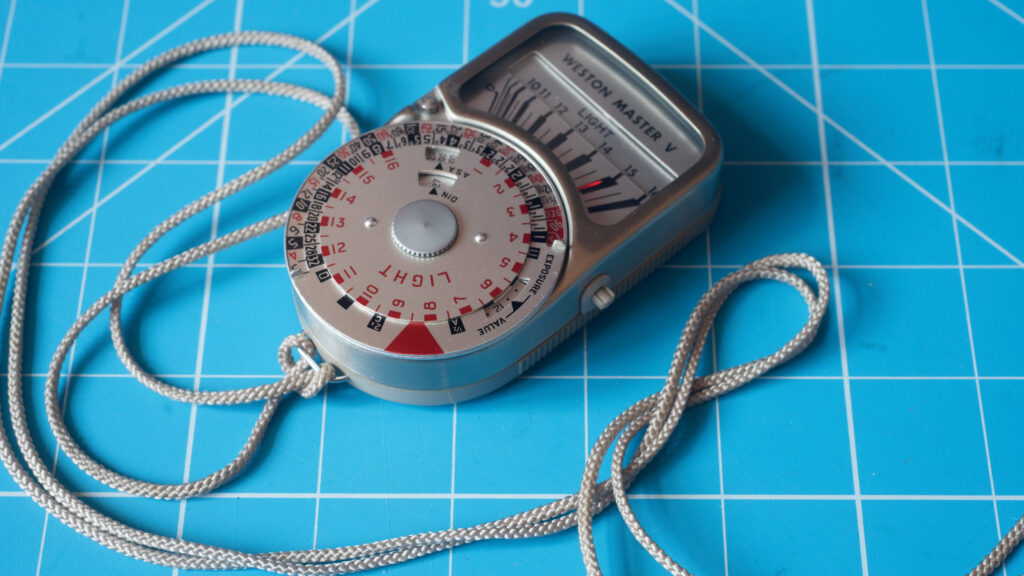
Master V features
The Master V meter is a neat little unit. It is finished in brushed metal and grey plastic. Intensity of light is measured by a large round selenium cell on the back of the meter. In normal use (outdoors), the selenium cell is covered by a baffle with holes in it. In low light (indoors), the baffle can be folded back, at which point a different scale (for low light) is shown.
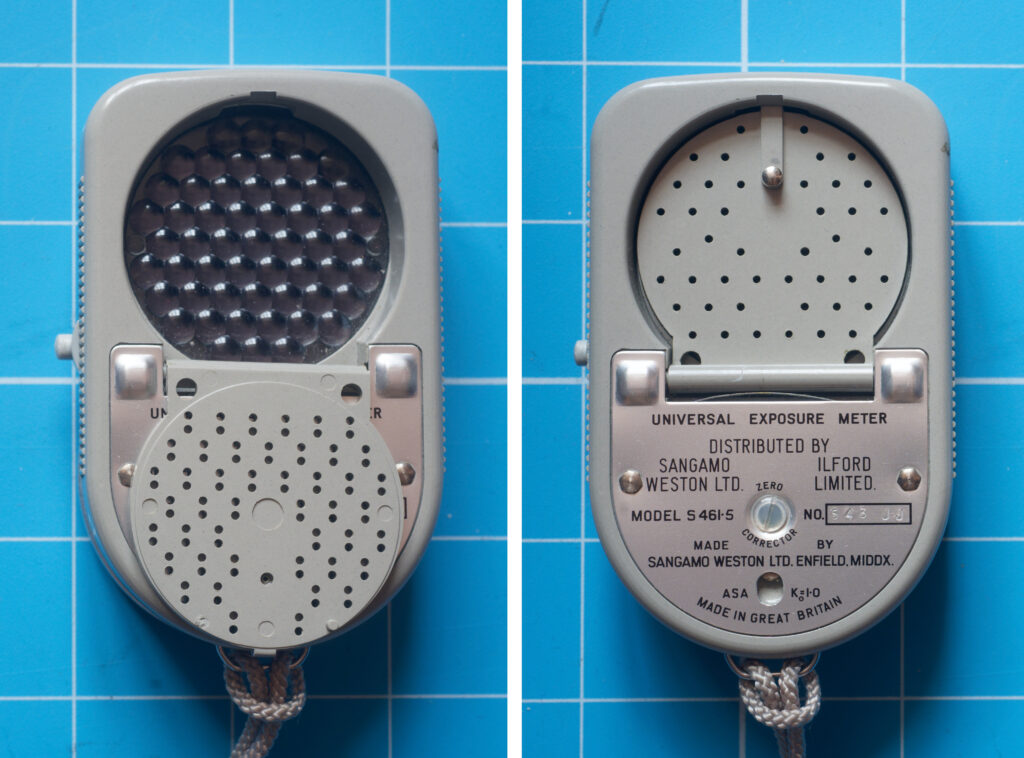
Film speed readings are input by pressing a little lock button at the NW position on the dial while turning the centre disk.
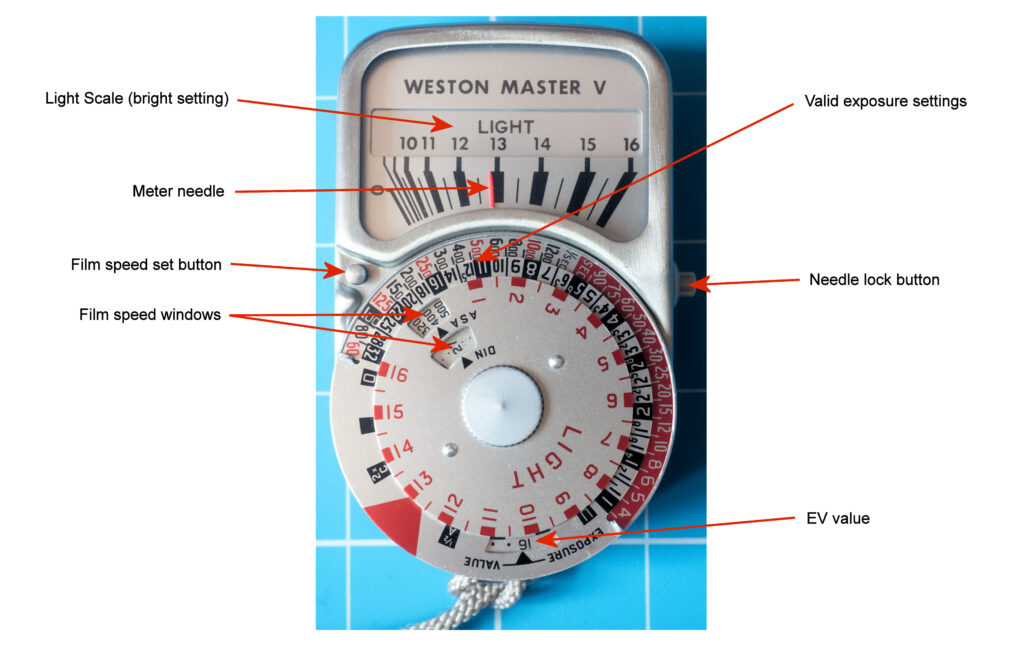
The numbers that the meter needle points at are quite arbitrary (earlier scales were in lumens), but the key thing is that they sit a stop apart. You take a reading by pressing the little button on the right side of the meter; this frees the needle, which then locks in place when the button is released.
The value from the meter is then transferred to the circular dial, aligning the big red wedge pointer to the appropriate red ‘LIGHT’ number. Once this is done, you can either choose one of the f-stop/shutter speed combinations shown on the edge of the disk, or you can read off the Exposure Value (EV) number and set that on your camera (if your camera uses EV values).
All this is quite straightforward and quite common to other light meters. So what is special about the Weston V and its stable-mates?
It is a robust, convenient and well designed little meter. I first came across these when I was doing a photography course at school (I had persuaded the school to run it for sixth-formers). The standard cameras the school got in were Practica m42 mount cameras with built-in meters but the school also got in some Weston meters (I think the V, although it would have been out of production for a few years by then). The Weston was impressive enough that I picked one up for myself a few years ago.
The other nifty little feature of the Weston Master meters is their ability to take incident light readings when using an ‘Invercone’.
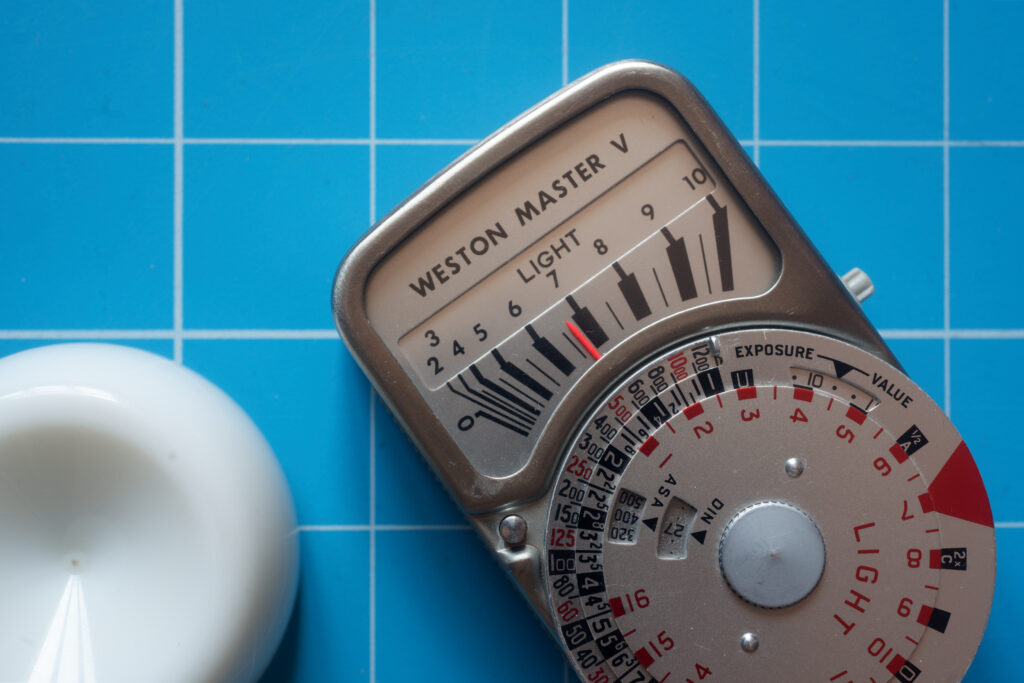
Invercone
In truth the Invercone buggers up the ergonomics of the Weston V quite a bit. It goes from being an instrument that can simply slip into a pocket, to something that is twice the depth and can separate into two bits rather more easily than anyone would like. However, it does work and can be very useful for ‘tricky’ lighting situations. Simply put, rather than measuring the light reflected from the subject and assuming a roughly 18% reflection of light, you hold the light meter and Invercone in front of the subject, pointing back at the source of light and take your reading from there.
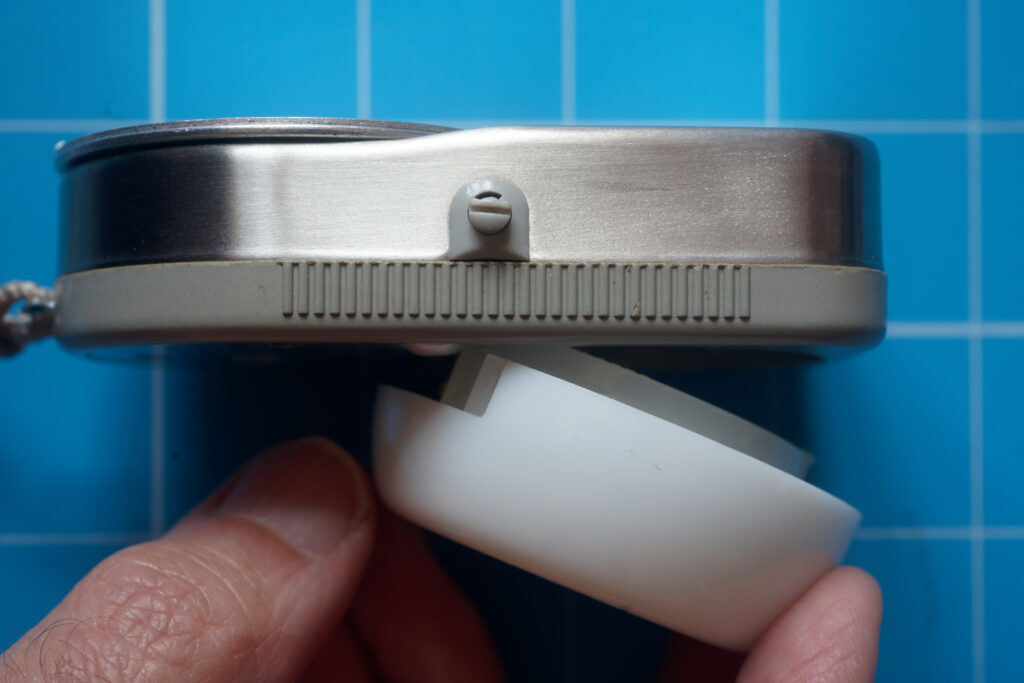
Now, incident light readings are not unique, but the Invercone claims to be shaped to reliably meter light falling on the subject from a number of angles. I’ve even seen a claim that the bit where the cone overlaps the top of the Weston V is a deliberate design to also capture an element of backlight. Personally I’m a bit sceptical about that, but it has to be said that the Invercone works.

Exposure Values
They were never all that common, but some older cameras use an Exposure Value (EV) system. These allow you to manually set an EV value which locks the shutter speed and aperture together, meaning that you can effectively ‘shift’ the exposure by moving both rings together. As you do this the shutter speed and aperture maintain the same exposure. It is a great system for use in circumstances where the overall light stays the same. Effectively, you meter once, then shoot until the light changes.
I have just two cameras that use Exposure Values, one is an aged ‘Super Frankarette’ with an f/2.8 Schneider-Kreuznach Xenar lens, and the other is an Olympus 35 SPn.
If I set an EV number for either camera, it should show the same set of f-stop and shutter speed combinations as shown on the Weston meter. I decided to experiment and the results were… inconclusive.
Set to an EV of 12, the Olympus suggests the same 1/60 at f/8.0 (and equivalents), as the Weston V. However, the Super Frankarette suggests f/5.6 to go with 1/60. It is ball-park but I’m curious as to why the older German camera wants to let in twice the light that the Weston and the Olympus think is appropriate.
Why?
Why would anyone want a Weston Master meter in 2025? We are surrounded by lots of clever devices that allow us to gauge exposure very well. We have built-in TTL meters, spot meters, matrix meters, clever little meters that clip into camera accessory shoes and even apps that turn a smartphone into a sophisticated light meter. On top of this, our films generally have enough latitude to tolerate some really quite bad exposure choices.
Let’s face it, from a purely practical point of view, it is difficult to justify shooting any analogue camera in a modern environment. But at the end of the day, they are nice bits of kit. A lot of vintage cameras are now very expensive, but the Weston Meters are, at time of writing, quite affordable. When you use one, you realise that you are using something that works exceptionally well. It is at the top of its tree, second to none. I don’t need one, but I like using it.
After the V
Following on from the V, Sectonic made a Master 6 in Japan but production would seem to have stopped in the mid-1970s. Sangamo Weston produced a Weston Euro-Master model in 1973. The Euro-Master looks to be quite similar to the V, but with a less busy dial. It was manufactured in Enfield until 1980. At that point, Sangamo Weston decided to get out of light meter manufacture.
After Sangamo Weston stopped making light meters, a former member of staff set up a company in East Kilbride (called East Kilbride Instruments) to continue production. At this time the Weston name was dropped and so the East Kilbride meters are simply labelled Euro-Master. When East Kilbride Instruments went into liquidation in 1984, manufacture was taken on by Megatron. Although it may sound like an evil robot, it was actually a company specialising in photoelectric cells, based in Tottenham. Megatron introduced a Euro-Master II in 1985. They continued to produce the Euro-Master II until they, in turn, went out of business in 2010.
The Sangamo name still lives on in the UK as a company that manufactures time switches and heating controls in Port Glasgow on the banks of Loch Lomond. The metering division of the old UK Sangamo now operates out of Felixstowe in Sussex as Iton Metering Solutions.
Sectronic still make light meters.
Share this post:

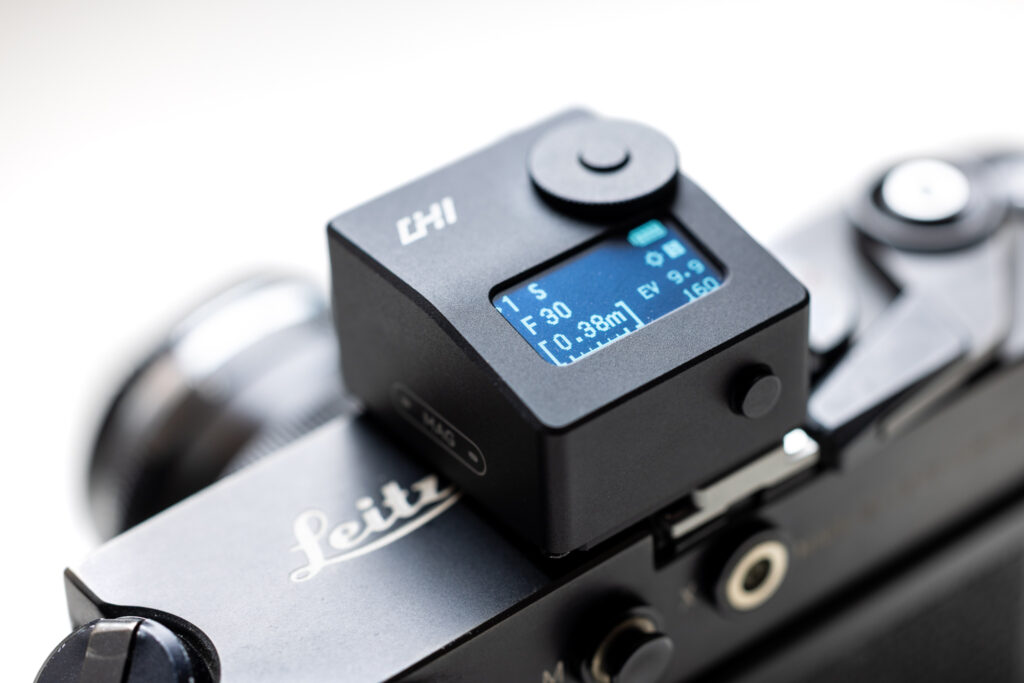
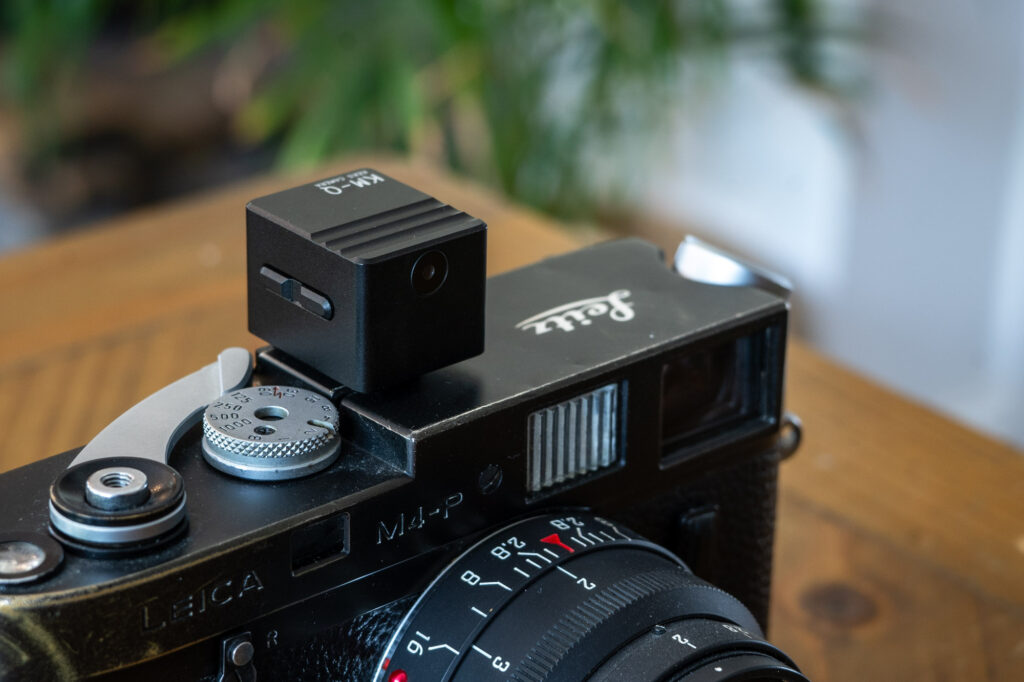
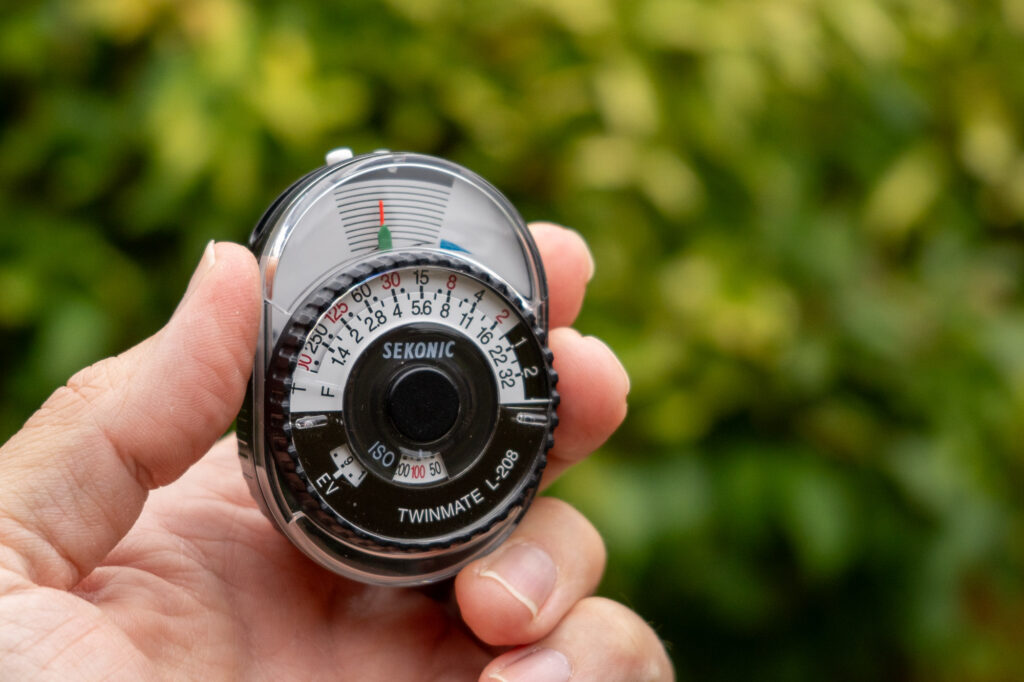
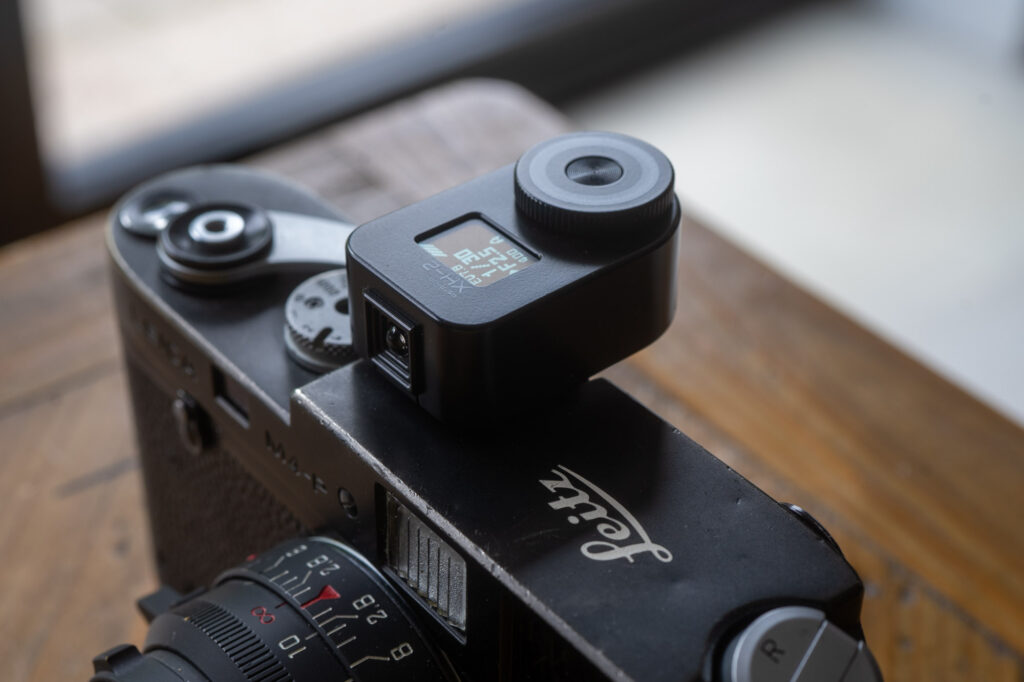
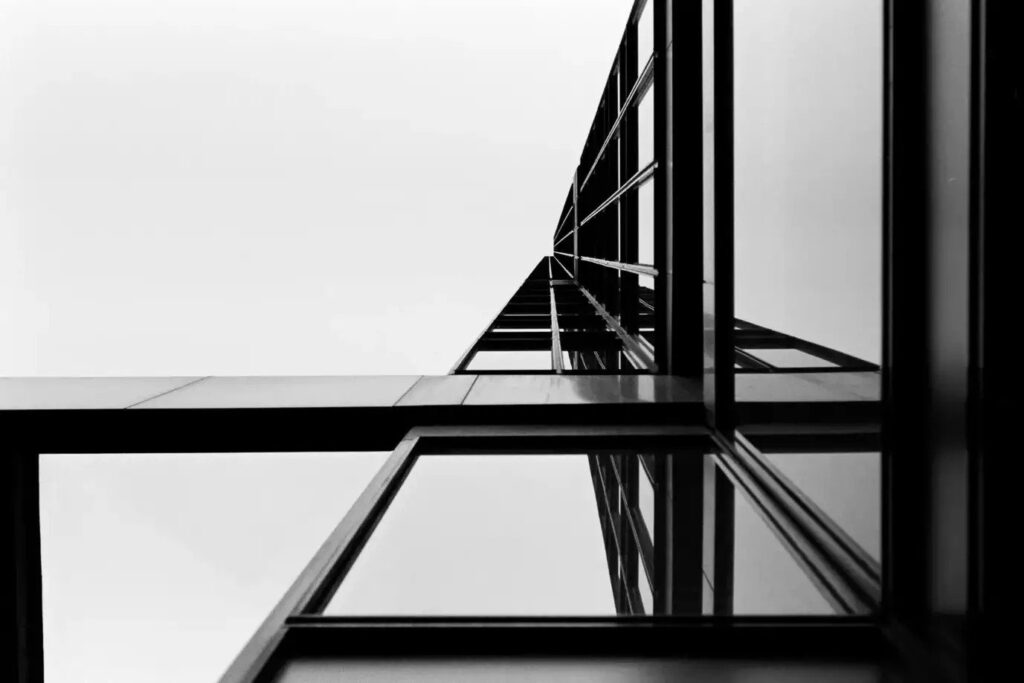
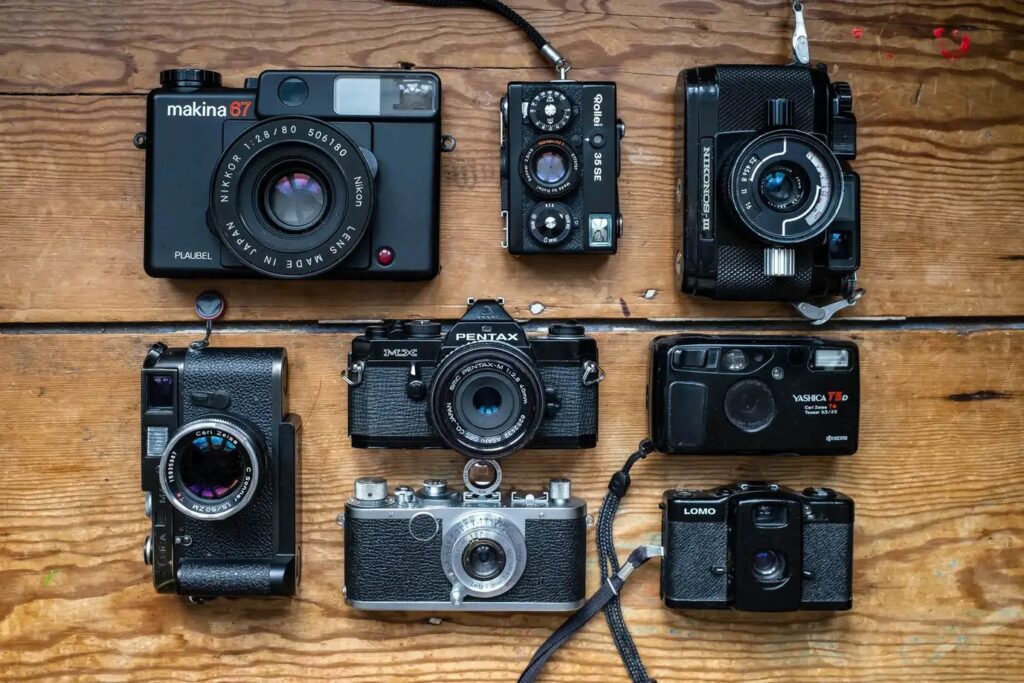
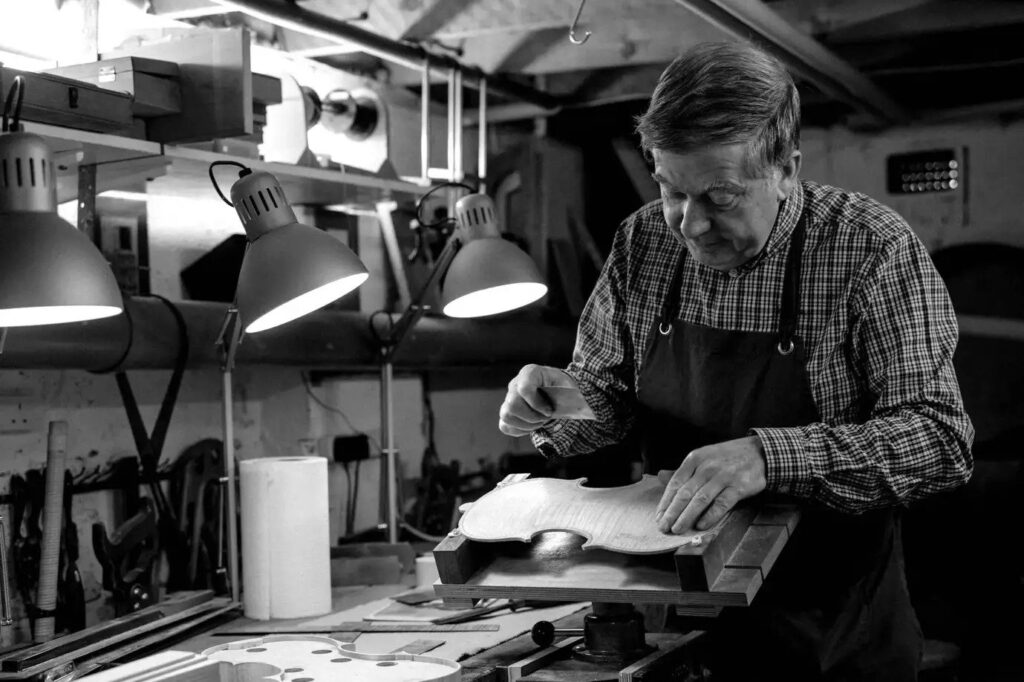
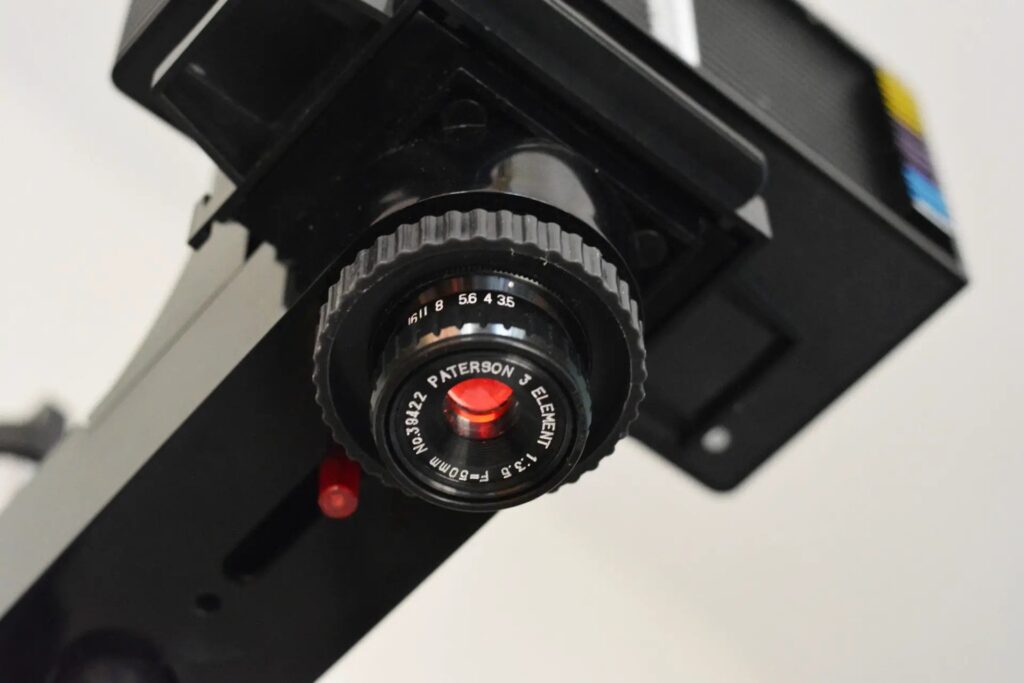
Comments
Helge Frisenette on Weston Master V – a Review of the Masterful Exposure Meter
Comment posted: 20/06/2025
Comment posted: 20/06/2025
David Hill on Weston Master V – a Review of the Masterful Exposure Meter
Comment posted: 20/06/2025
Comment posted: 20/06/2025
Nigel Cliff on Weston Master V – a Review of the Masterful Exposure Meter
Comment posted: 20/06/2025
jfbonnin on Weston Master V – a Review of the Masterful Exposure Meter
Comment posted: 20/06/2025
Comment posted: 20/06/2025
Fred Stock on Weston Master V – a Review of the Masterful Exposure Meter
Comment posted: 20/06/2025
When the meter is stored between use in a cool, dry and dark place the Selenium cell will last for decades and keep its accuracy.
The V is less accurate than modern electronic meters but that didn’t matter in the sixties and seventies when silverrich black and white film emulsions permitted one stop over or under exposure.
Fernando Vazquez Santos on Weston Master V – a Review of the Masterful Exposure Meter
Comment posted: 20/06/2025
James-T on Weston Master V – a Review of the Masterful Exposure Meter
Comment posted: 20/06/2025
A rather curious piece of trivia about the company. It was founded by an Edward Weston, but has no connection with the famous photographer of the same name (who disliked exposure meters). This one was a US-based English electrical engineer.
davesurrey on Weston Master V – a Review of the Masterful Exposure Meter
Comment posted: 20/06/2025
I assume that most folk on here like to use old equipment that, quite honestly, usually can’t compete with the newer digital kit. But that’s not the point and they prefer the usability and the fun of squeezing out results from the older stuff. I am one of those.
Over the years I have had, and still have, several light meters from Gossen, Weston, Sekonic and Zeiss Ikophot all of which I have enjoyed using. Some have been way off in accuracy but some have been surprisingly accurate compared with my other dedicated meters, digital cameras and smartphone apps, if one takes into consideration the different angles of measurement.
But I’ll be honest and say that for convenience in having it with me at all times my phone app is the one I use most unless I have my Gossen Lunasix 3s which is extremely sensitive.
Ibraar Hussain on Weston Master V – a Review of the Masterful Exposure Meter
Comment posted: 20/06/2025
and a trip down to the days when Britain used to make useful practical long lasting things, Tottenham had a lot of industry including Racing Bikes which I like
Jeffery Luhn on Weston Master V – a Review of the Masterful Exposure Meter
Comment posted: 20/06/2025
Alain BLOND on Weston Master V – a Review of the Masterful Exposure Meter
Comment posted: 20/06/2025
http://briseux.free.fr/
Gary Smith on Weston Master V – a Review of the Masterful Exposure Meter
Comment posted: 20/06/2025
I find that sometimes after fiddling with the dials on my little clip-on TTArtisan meter on my M3 that I forget to set the Camera!
A.G.E.
Comment posted: 20/06/2025
Comment posted: 20/06/2025
Tony Warren on Weston Master V – a Review of the Masterful Exposure Meter
Comment posted: 20/06/2025
David Hume on Weston Master V – a Review of the Masterful Exposure Meter
Comment posted: 21/06/2025
When I started shooting commercially with an RB 67 in the early 90s I was doing it very much on the cheap and so the Weston Master remained my meter until I sold the RB at the end of the film days.
I got used to using it and felt very comfortable. I used it for transparency almost exclusively. And frequently I was doing backlit shots through glass and other odd stuff with it. I found something strangely reassuring about watching the needle moving and calculating roughly in your head if what was telling you makes sense.
I used to use it mostly with the Invercone. I haven’t tested it recently, but I think the last time I did it was a bit out. The funny thing is I don’t know if it’s always been out and just gave me great results or it has drifted. I think it’s more likely that I just got used to it the way it was. Anyway, it did me well for many years shooting Velvia 50 with incident readings.
Thanks for the memories… It is a beautiful piece of cake and I don’t use it anymore. I’ve got a little Sekonic that I use if I’m shooting an unmetered camera. Cheers
Leon on Weston Master V – a Review of the Masterful Exposure Meter
Comment posted: 21/06/2025
Ahh, the Weston Master V and its descendants. Top of the tree in their day. Must have gadget used by “real” photographers. Set the men apart from the boys. Never held one but I do have and use a 45 year old Gossen Sixtar which I have had from new. Which is lovely to hold, use and is accurate.
I also have a recently purchased Sekonic Twinmate. It works. But by comparison it is a bit fiddly and feels cheap. A budget item.
Now if any one is interested my Sixtar started to play up. Lack of repeatability with the needle position. Both when taking a light reading and doing a battery test. Oh dear. Hence the Twinmate purchase.
Then I came across these people.
1st Aid Repairs - Camera Repair Shop UK | DSLR, SLR Camera & Camcorder Repair Centre, Kent
They are in Tunbridge Wells and also repair Gossen instruments.
Perhaps if someone enquired thy might be able to fix Weston Masters. Any way they charged me £60 to fix a number of faults in my Sixtar and they calibrated it. Comparing the Twinmate to it, the Twinmate’s readings are 1 stop overexposing. Well mine does and its the second one I’ve had. The first one lasted about an hour before its needle went wild and it had to be sent back.
James Evidon on Weston Master V – a Review of the Masterful Exposure Meter
Comment posted: 21/06/2025
It is still a reliable product and a cinch to calibrate. I'll never part with it.
Unfortunately, companies that service selenium cell exposure meters are a dying species and I am afraid that in the not too distant future, they too will be as dead as the Dodo bird.
Roger on Weston Master V – a Review of the Masterful Exposure Meter
Comment posted: 22/06/2025
One comment is that they come in different types of case (not shown in the review). My Master III had a zipped case, which I found much less convenient than the case with sides that fold back (the design on both the Master III and the EuroMaster. The folding sides design makes it easy to hold the meter up to the light, and there is no zip to corrode. The Euromaster also has a neat case to hold the invercone on the cord. Some people won’t attach any importance to this, but in my view the type of case makes a significant difference to ease of use.
Roger on Weston Master V – a Review of the Masterful Exposure Meter
Comment posted: 22/06/2025
Alejandro on Weston Master V – a Review of the Masterful Exposure Meter
Comment posted: 25/06/2025
Thomas Eland on Weston Master V – a Review of the Masterful Exposure Meter
Comment posted: 10/11/2025
I only started collecting and using vintage film cameras last year and was very lucky to get a Mint In Box absolutely unused Weston Master V from ebay and it even had the receipt from London Camera Exchange. Because it had been hidden from the light the selenium cell is perfect and gives great exposure times.
I've not tried the invercone as I don't take portraits. I carry the meter with me always, in its case but unzipped in the side pocket of my camera bag.
I was also lucky to get a Pentax spotmeter V from the bargain basket in the Camera Museum near the British Museum. Both meters are useful if you want to get into the Zone system.
I got a little clip-on Astrhori meter similar to the Artisan but I find it rather fiddly.